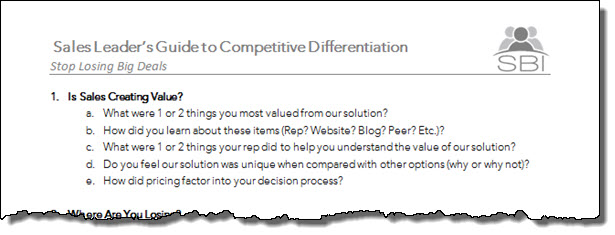I was recently asked this by the sales leader for a large software company. It was on the heels of losing a multi-million dollar opportunity. The fifth one in the last quarter.
You have hundreds of reps under your command. A big difference between winning and losing is differentiating from the competition. You can’t be on every sales call, so how do you know?
If this doesn’t happen, dozens of large opportunities are potentially lost each year. Good news: It’s early and this can help you turn things around quickly.
Start by downloading Sales Leader’s Guide to Competitive Differentiation.
The opportunity to learn differentiation from your failures is vast. Losing 6/10 times, gives you lots of chances to learn. Are you ready to take a look in the mirror?
- How much value does your sales team create?
Often, it’s clear internally why your solution is superior. You probably hear this all the time from your product team. The problem is the prospect isn’t clear.
Reps struggle to articulate unique value. When it comes time to make a decision, the prospect defaults to price. They view all options as the same. The lowest cost wins because that’s the only differentiator.
If you’re losing on price consistently, sales isn’t building value. This section of the tool will help you uncover this. The result will help you develop training content that delivers results. Rather than teach the same warmed-over garbage as last year, work on their weaknesses.
- Where in your sales campaigns are you losing?
If you are using a legacy sales methodology, this exercise will expose its flaws. Without the benefit of a prospect buying process, you risk losing. Your reps are selling the way they want to vs. how your prospects buy.
Is your funnel jammed with deals in the “proposal” phase in your CRM? This is a warning sign. Your reps are lobbing quotes over the fence and hoping for a miracle. Yet, no differentiation has been built into the deal, so the competition wins. Use the tool to determine where and why you’re losing.
- How do you stack up to the competition?
This is a great way to gain insight into how your competition differentiates. In the moment of truth, this will expose your execution gaps. If you can’t beat them consistently, here is how you find out why.
The tool provides a series of criteria to measure you against the best. If you need to fix sales issues, this focuses you on the right things.
How to Use This Tool
You might ask the rep fill out the guide as a template. This is a mistake and a waste of time. Reps will tell you the product was insufficient. Or, your price was too high. This is not insightful and will not help you affect change.
To derive full value, this conversation needs to happen one-on-one with the prospect. If there were multiple buying influences in a deal, interview each of them separately. Each should take about 45 minutes.
Who Should Do This?
This is not a job for the rep or their direct manager. The prospect is unlikely to reveal their true feelings. And, you may end up with biased feedback. Here are a few options for you:
- VP of Sales (You)
- Sales Operations
- Product Management
- Marketing Operations
Frequency
For every big deal you lose, request a conversation from each buying team member. What do you have to lose besides more big deals? If you’re looking to differentiate your sales force, start by learning from your failures.
This foundational activity could exponentially increase the impact of your efforts. You will focus your team on fixing the right things and create true differentiation.




